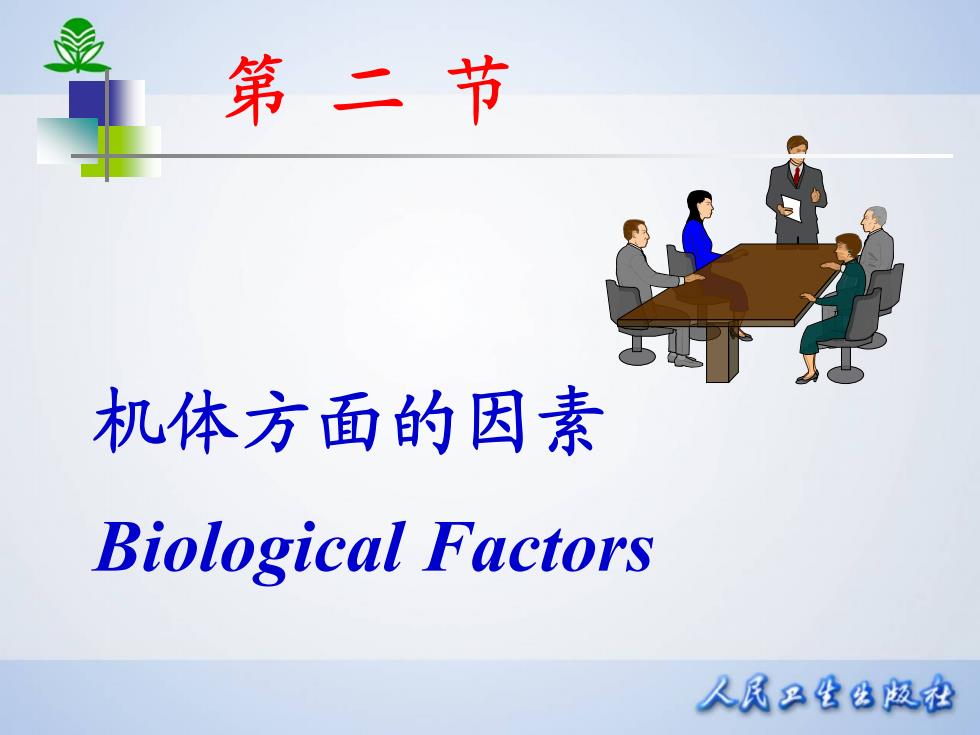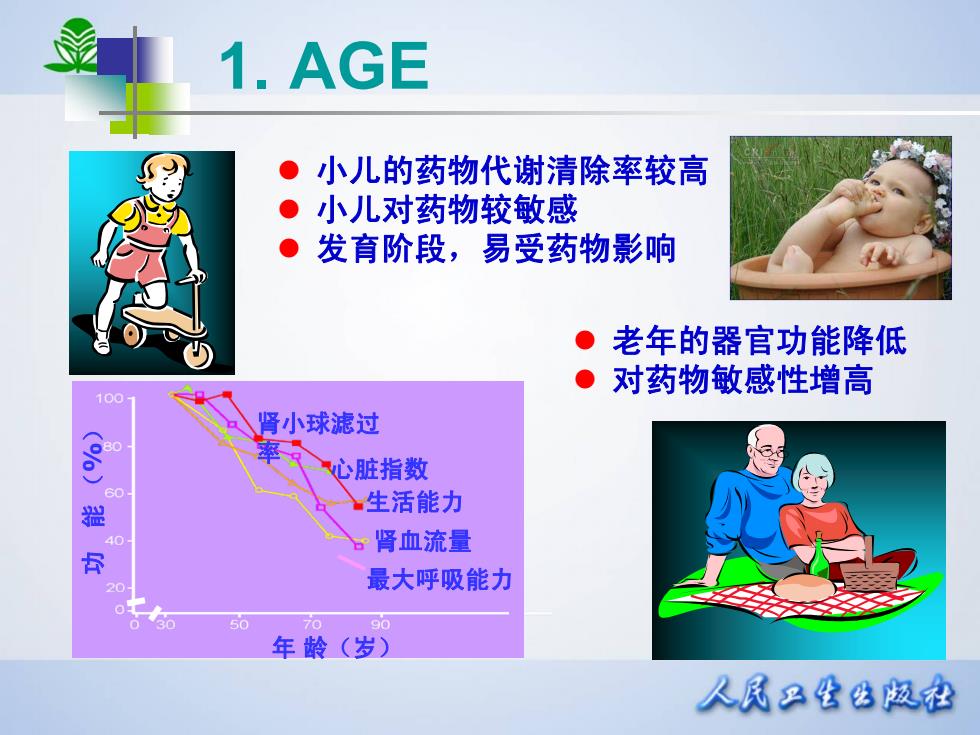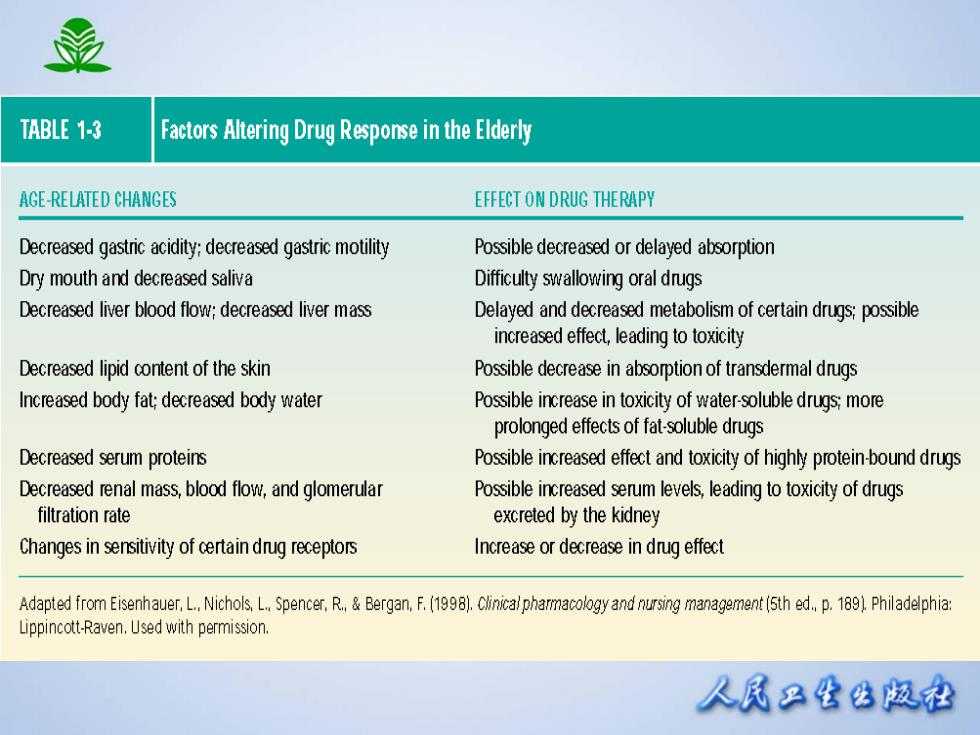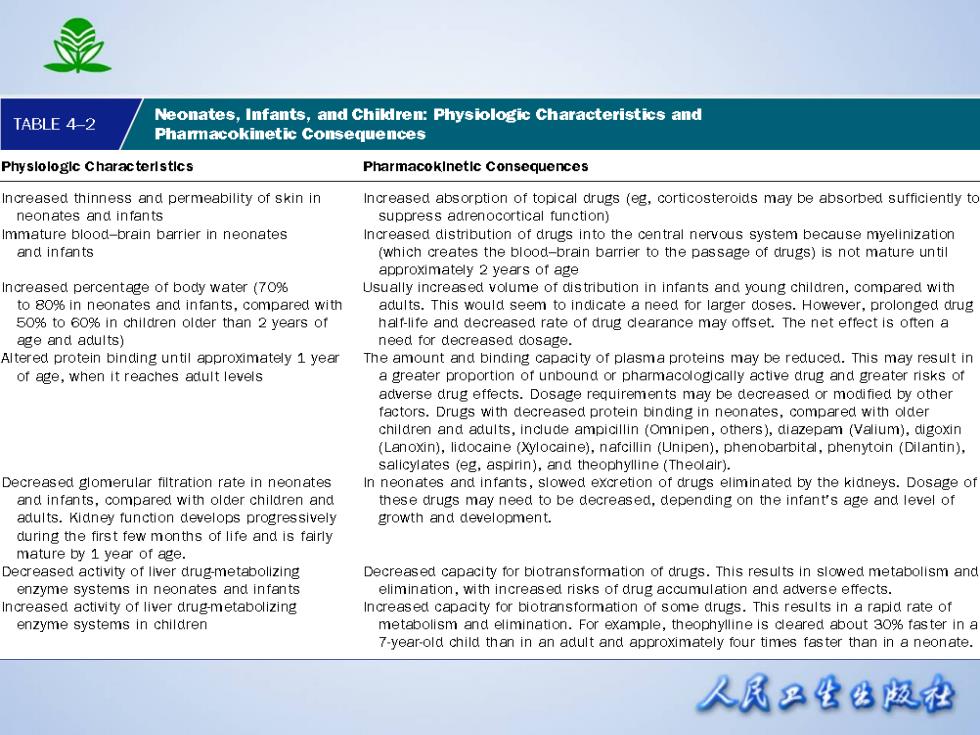
第二节 机体方面的因素 Biological Factors 人民口生名版松
机体方面的因素 Biological Factors 第二节

1.AGE ● 小儿的药物代谢清除率较高 ●小儿对药物较敏感 ●发育阶段,易受药物影响 ● 老年的器官功能降低 对药物敏感性增高 肾小球滤过 ( 率 心脏指数 生活能力 肾血流量 最大呼吸能力 年龄(岁) 人凤只坐公版松
小儿的药物代谢清除率较高 小儿对药物较敏感 发育阶段,易受药物影响 老年的器官功能降低 对药物敏感性增高 1. AGE 年 龄(岁) 肾小球滤过 率 心脏指数 生活能力 肾血流量 最大呼吸能力 功 能( % )

TABLE 1-3 Factors Altering Drug Response in the Elderly AGE-RELATED CHANGES EFFECT ON DRUG THERAPY Decreased gastric acidity:decreased gastric motility Possible decreased or delayed absorption Dry mouth and decreased saliva Difficulty swallowing oral drugs Decreased liver blood flow;decreased liver mass Delayed and decreased metabolism of certain drugs;possible increased effect,leading to toxicity Decreased lipid content of the skin Possible decrease in absorption of transdermal drugs Increased body fat;decreased body water Possible increase in toxicity of water-soluble drugs;more prolonged effects of fat-soluble drugs Decreased serum proteins Possible increased effect and toxicity of highly protein-bound drugs Decreased renal mass,blood flow,and glomerular Possible increased serm levels,leading to toxicity of drugs filtration rate excreted by the kidney Changes in sensitivity of certain drug receptors Increase or decrease in drug effect Adapted from Eisenhauer,L.Nichols,L.Spencer.R.&Bergan,F.(1).hamalgyndsingmanagemnt (5th ed.p.8)Philadelphia: Lippincott-Raven.Used with permission. 人凤只坐公版松

TABLE 4-2 Neonates,Infants,and Children:Physiologic Characteristics and Phammacokinetic Consequences Physlologlc Characterlstics Pharmacokinetic Consequences Increased thinness and permeability of skin in Increased absorption of topical drugs (eg,corticosteroids may be absorbed sufficiently to neonates and infants suppress adrenocortical function) mmature blood-brain barrier in neonates Increased distribution of drugs into the central nervous system because myelinization and infants (which creates the blood-brain barrier to the passage of drugs)is not mature until approximately 2 years of age Increased percentage of body water (70% Usually increased volume of dis tribution in infants and young children,compared with to 80%in neonates and infants,compared with adults.This would seem to indicate a need for larger doses.However,prolonged drug 50%to 60%in children older than 2 years of half-life and decreased rate of drug clearance may offset.The net effect is often a age and adults) need for decreased dosage. Altered protein binding until approximately 1 year The amount and binding capacity of plasma proteins may be reduced.This may result in of age,when it reaches adult levels a greater proportion of unbound or pharmacologically active drug and greater risks or adverse drug effects.Dosage requirements may be decreased or modified by other factors.Drugs with decreased protein binding in neonates,compared with older children and adults,include ampicillin (Omnipen,others),diazepam (Valium),digoxin (Lanoxin),lidocaine (Xylocaine),nafcillin (Unipen),phenobarbital,phenytoin (Dilantin). salicylates (eg,aspirin),and theophylline(Theolair). Decreased glomerular filtration rate in neonates In neonates and infants,slowed excretion of drugs eliminated by the kidneys.Dosage of and infants,compared with older children and these drugs may need to be decreased,depending on the infant's age and level of adults.Kidney function develops progressively growth and development. during the first few months of life and is fairly mature by 1 year of age. Decreased activity of liver drug-metabollzing Decreased capacity for blotransformation of drugs.This results in slowed metabollsm and enzyme systems in neonates and infants elimination,with increased risks of drug accumulation and adverse effects. Increased activity of liver drug-metabolizing Increased capacity for biotransformation of some drugs.This results in a rapid rate of enzyme systems in children metabolism and elimination.For example,theophylline is cleared about 30%faster in a 7-year-old child than in an adult and approximately four times faster than in a neonate 人凤只生公版松